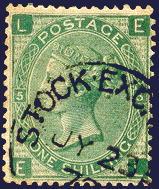 |
 |
|
Note the blunt corner. On the genuine stamps the corners of the stamp and other details are much sharper. |
Evidence of the Stock Exchange Forgery surfaced first in early 1898, when Charles Nissen, the author of The Plating of the Penny Black Stamps of Great Britain, 1840, discovered examples of "Plate 5" and "Plate 6." The forgeries were used on telegraph forms at the Stock Exchange, and would have escaped notice had they been destroyed after use which was the normal procedure. They apparently, based upon the dates on the circular date stamps, were used during 1872 and 1873.
The telegraph forms were franked with the forged stamps and the clerk
participating in the fraud would pocket the cash. Since
the clerk used the forged stamps, the stock of genuine stamps would
not be depleted, thus concealing the fraud. The public would
get nothing more than a brief glimpse at the telegraph form, which would
be filed and later placed in bags for destruction. The discovery
was made possible due to the fact that the bags were taken from storage
instead of
destroyed and the stamps were sold to dealers.
The forgery of Plate 6 is scarcer than Plate 5 and somewhat better executed.
The stamps from both plates exist with "normal"
check letter combinations, and non-existent combinations.
The forgers made the error of creating check letter combinations
which exceeded the normal range of the letter "L." The
forged stamps are similar to the issue of the period, with large white
check letters. The physical characteristics of the forgeries
are as follows:
| Check letters: Go beyond the letter "L." |
| Slightly larger than on genuine stamps. |
| Check letter square corners somewhat blunted. |
| Watermark: None. The genuine stamps would be Spray |
| of Rose |
| Perforation: The forgery is perforated 14 as is the genuine |
| Printing method: Lithographed. Genuine is typographed |
| The forged stamps have a very slight blurred |
| appearance |
Example of "Plate 5"
 |
 |
|
Note the blunt corner. On the genuine stamps the corners of the stamp and other details are much sharper. |